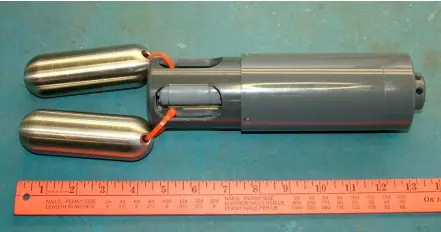T7 - Data Logger
Large Ruminant - For Cannulated Animals

The T7 data logger (sometimes referred to as model T7-1 LRCpH) is a specialized device designed for long-term monitoring within the rumen of large, cannulated ruminant animals (cattle, calves, sheep). Here's a comprehensive overview of its key features and applications:
🧪 What It Measures
- pH – continuously tracks ruminal acidity to help detect conditions like subacute ruminal acidosis.
- Temperature – monitors rumen temperature fluctuations.
- Oxidation–Reduction Potential (ORP) – often termed redox potential; useful for assessing fermentation and microbial activity nexusacademicpublishers.com+3Frontiers+3ResearchGate+3nexusacademicpublishers.comonsetcomp.com+1eBay+1.
📦 Form Factor & Design
- Shrouded sensor capsule: pH probe is housed within a protective shroud to allow fluid passage while preventing epithelial contact.
- Weighting mechanism: Metal weights attached to maintain a vertical, ventral sac position Frontiers.
- Size: Roughly ~21 mm diameter and ~140 mm long (T9 version; T7 is similar).
- Battery-powered: Typically powered by ½‑AA lithium cells, lasting several weeks or more.
🎯 Deployment & Fixation
- Cannula attachment: Capsule often affixed to rumen cannula to ensure stability inside the ventral sac ResearchGate+2Frontiers+2nexusacademicpublishers.com+2.
- Weighted for position: Weights help it sink vertically, ensuring consistent placement.
⏱️ Data Collection & Duration
- Sampling frequency: Measures parameters at intervals (e.g., every 5 or 10 minutes) star-oddi.com+1Amazon+1.
- Long-term use: Can remain in the rumen for days to weeks—studies have used it reliably for 3–4 weeks ResearchGate.
- Calibration: Pre‑ and post‑use standardization performed in pH 4 and 7 buffers to convert raw mV values to accurate pH ResearchGate+2nexusacademicpublishers.com+2Frontiers+2.
📊 Data Quality & Accuracy
- High correlation: Studies show strong consistency between sensors (intra-class correlation coefficients ~0.7–0.8) over 2–4 weeks .
- Error margins: Maximum measurement error ~0.10–0.18 pH units between calibrations Amazon.
🧬 Research Applications
- Widely used in nutritional and metabolic studies: to monitor rumen dynamics during diet transitions, metabolic stress, or microbiome shifts .
- Helps quantify minimum, mean, maximum pH, time below critical thresholds (e.g., <6.0), and area under the pH-time curve.
✅ Advantages
- Continuous real-time monitoring: Offers far richer datasets than intermittent sampling.
- Stays in place: Designed to maintain consistent sensor orientation and location.
- Multi-parameter: Simultaneously tracks pH, temperature, ORP—offering a fuller picture of rumen conditions.
- Durable: Meant for prolonged use (weeks), with robust calibration procedures.
🔧 Considerations & Best Practices
- Routine recalibration (e.g., after 72 hrs) ensures accuracy Frontiers.
- Probe wear: As sensors age, readings may drift—be sure to conduct post-use calibrations.
- Proper deployment: Use cannula attachment and weights to prevent movement in the rumen.
- Data handling: Large time-series datasets require adequate storage and analysis tools.
📚 Summary
The T7 is a robust, rumen-compatible pH/temperature/ORP data logger, purpose-built for long-term, in-situ monitoring in large animals. It’s reliable for multi-week deployment, offers high-precision data when properly calibrated, and plays a vital role in rumen physiology and nutrition research.